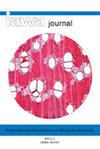萨尔瓦多Chalatenango中新世樟科的多样化组合
IF 3.5
3区 农林科学
Q2 FORESTRY
引用次数: 0
摘要
中美洲的古植物群很少为人所知,在这种情况下,来自萨尔瓦多查拉特南戈中新世的树木被报道。鉴定是通过细切片进行的,可以观察到解剖模式。后来,他们与文献中已经描述的现有和化石分类群的树木进行了比较。化石标本呈现出樟科几个现存属共有的特征,因此归属于樟科。然而,由于樟科各属间树木的变异性较低,在没有其他植物器官的情况下,将其划归当前属是不确定的。我们发现了3个化石属中的5个新种:Argapaloxylon salvadorensis、Laurinoxylon scalariformme、Mezilaurinoxylon miocenica、M. americana和M. oleiferum。此外,我们将木材分配给一个已经描述的物种,L. chalatenangensis。在中美洲和墨西哥南部,森林和丛林中的月桂类植物种类繁多,占主导地位。这里描述的标本代表了新的证据,表明这种植被类型可能已经存在了大约1500万年。然而,即使在这个时候,当前的属也不能得到承认,这是令人震惊的。要更详细地了解所涉及的谱系,就需要对现存植物和灭绝植物进行更密切的比较。本文章由计算机程序翻译,如有差异,请以英文原文为准。
A diverse assemblage of Miocene Lauraceae in Chalatenango, El Salvador
The paleofloras of Central America are little known, and on this occasion, woods from the Miocene of Chalatenango, El Salvador, are reported. The identification was carried out from the elaboration of thin sections that allowed observation of anatomical patterns. Later, they were compared with woods of current and fossil taxa already described in the literature. The fossil specimens presented characteristics shared by several current genera of Lauraceae, so they were assigned to this family. However, since the variability of the woods between the genera of Lauraceae is low, it was uncertain to assign them to the current genera without having other plant organs. We recognize five new species in three fossil genera: Argapaloxylon salvadorensis, Laurinoxylon scalariforme, Mezilaurinoxylon miocenica, M. americana, and M. oleiferum. In addition, we assign a wood to an already described species, L. chalatenangensis. In Central America and southern Mexico, there is a great diversity and dominance of lauraceous plants in forests and jungles. The specimens described here represent new evidence suggesting that this vegetation type may have existed for approximately 15 million years. However, that current genera cannot be recognized even at this time is striking. A more detailed history of the lineages involved requires a closer comparison of existing plants with extinct ones.
求助全文
通过发布文献求助,成功后即可免费获取论文全文。
去求助
来源期刊

IAWA Journal
农林科学-林学
CiteScore
3.40
自引率
15.80%
发文量
26
审稿时长
>36 weeks
期刊介绍:
The IAWA Journal is the only international periodical fully devoted to structure, function, identification and utilisation of wood and bark in trees, shrubs, lianas, palms, bamboo and herbs. Many papers are of a multidisciplinary nature, linking
 求助内容:
求助内容: 应助结果提醒方式:
应助结果提醒方式:


